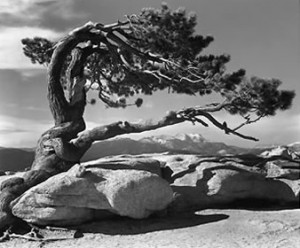
In traditional black and white photography, the aim is to present a picture where there is at least one area of the picture which is as dark as your display medium, whether it be printed paper or a computer screen, will allow and another area which is as bright as it is possible to be.
If you have achieved this, the picture is said to have maximum contrast and the image will appear punchy and alive, with very rich tones.
Pictures with too little contrast appear dull and grey and can even be described as muddy. In the days when I worked in a darkroom, I never tired of the tremendous difference between a flat, tonally poor print and that of a full contrast photograph of the exact same negative.
As with all good things in life, one can have too much contrast in ones images. If a picture is displayed with too much contrast, the detail in the lightest and darkest areas of the image will disappear into black and white. While this is acceptable for small parts of the photograph, it can be troublesome if huge swathes of detail are lost into oblivion.
There are, of course, situations where the photographer will intentionally create a lower contrast image, with whites that are not completely white or where the darkest parts of the image is toned in grey rather than in full black, but the key is to be able to get to full range of contrast from your display medium, and then break the rules if you need to do so for visual effect.
Contrast has been taken so seriously by photographers over the ages that Ansel Adams, arguably the finest black and white landscape photographer in American history, devised a system to get the maximum amount of contrast out of every single picture he printed.
The Zone System for Digital Photography
The zone system is basically a technique used to display pictures with the full tonal capabilities of the display medium. Though Ansel Adams applied the system mainly to pictures printed in a wet chemical darkroom, the system is as relevant, regardless of whether you are shooting on a digital camera or on negative, and whether you intend to display on a laptop screen or a wet chemical print.
In the zone system, the properties of the display medium are assessed, and the range of tones that it is capable of producing is divided into ten zones. The first zone, zone zero equates to complete black, as dark as you can get out of your medium, zone one can be described as near black, with detail just about visible in the shadows. Zone two would represent dark grey, while zone three holds the tones in the medium dark area. Zone four is the shades just darker than the average and zone five those just lighter. Zone six will be medium light grey while zone seven is best described as light grey. Zone eight holds all the lightest detail just visible before it disappears into zone nine, pure white.
When Ansel Adams printed his masterful work, he always made sure that each of these areas was represented in the final print. This ensured that his photographs always contained the full tonal range available and gave his images an unrivalled richness and vibrancy.